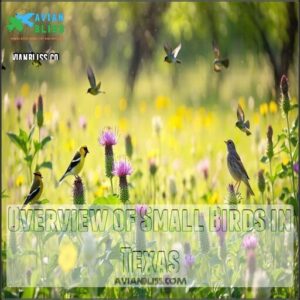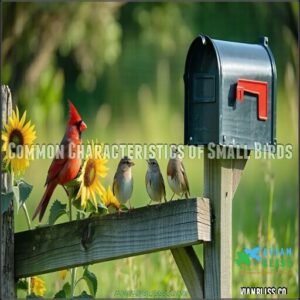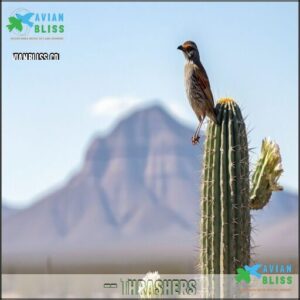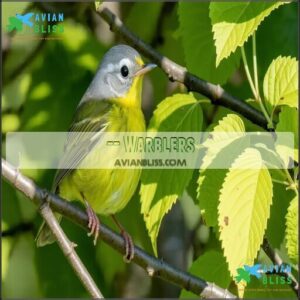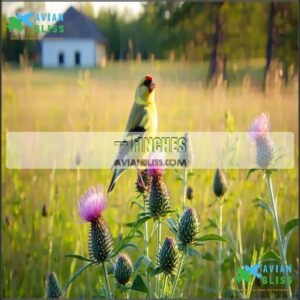This site is supported by our readers. We may earn a commission, at no cost to you, if you purchase through links.
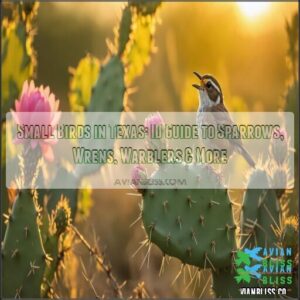
You’ve got sparrows, like the white-crowned and chipping, with their crisp markings, and wrens, such as the Carolina wren, known for its bold song that’s louder than you’d expect from such a tiny frame.
Warblers flit through during migration, flashing yellow and black like nature’s highlighters.
Don’t forget finches, like the house finch, with its cheerful red splash.
Whether you’re spotting them in your backyard or on a hike, these feathered friends make Texas skies anything but boring.
Curious about attracting more? Stay tuned.
Table Of Contents
- Key Takeaways
- Overview of Small Birds in Texas
- Common Characteristics of Small Birds
- Identifying Small Brown Birds
- — Sparrows
- — Wrens
- — Thrashers
- — Titmice
- — Warblers
- — Finches
- Encouraging Small Bird Diversity in Your Yard
- Frequently Asked Questions (FAQs)
- What kind of birds live in Texas?
- What is the smallest bird found in Texas?
- Which bird is most commonly seen in Texas?
- Do small birds live in Texas?
- What are the most common backyard birds in Texas?
- What birds visit bird feeders in Texas?
- What are the tiny little brown birds called?
- How can I identify a bird in my yard?
- What is a most common little bird?
- What are the tiny birds that hop around?
- Conclusion
Key Takeaways
- Texas is home to a wide range of small birds like sparrows, wrens, warblers, and finches, each with unique traits and habitats.
- Migration seasons bring even more bird species, making Texas a vibrant birdwatching spot year-round.
- You can attract small birds to your yard with native plants, water sources, and a variety of feeders offering seeds and suet.
- Focus on size, behavior, plumage patterns, and songs to identify birds effectively in your area.
Overview of Small Birds in Texas
Texas birding offers a kaleidoscope of feathered friends, from the tiniest Calliope Hummingbird, just 3.25 inches long, to an array of colorful warblers and sparrows.
A kaleidoscope of feathered friends awaits in Texas, from vibrant warblers to the tiny Calliope Hummingbird, just 3.25 inches long.
With over 660 Texas bird species, you’ll find endless opportunities for discovery. The state’s diverse bird habitats—spanning swamps, deserts, and coastal wetlands—create perfect homes for these winged wonders.
Seasonal bird migration adds even more excitement, as new species arrive with the changing weather. Whether you’re spotting a Song Sparrow in your yard or scanning for warblers in the woods, Texas bird watching never disappoints.
So grab your binoculars, embrace the thrill of Texas bird identification, and let these small birds brighten your day! Many birdwatchers enjoy spotting the American Goldfinch in their backyards.
Common Characteristics of Small Birds
Small birds in Texas are nature’s tiny wonders, each equipped with traits that tell their survival stories.
Their size and weight make them agile, while their plumage variations blend them into surroundings or attract mates.
Notice their feeding habits—seed-cracking beaks or nectar-sipping bills reveal their diets.
Their vocalizations range from melodic chirps to sharp calls, each serving communication or defense.
Feather color attracts mates for some species.
- Seed-cracking beaks: Perfect for sparrows.
- Bright plumage: Cardinals flaunt it!
- Hidden nests: Mailboxes, anyone?
- Chirps and calls: Nature’s music box.
Identifying Small Brown Birds
Identifying those small brown birds fluttering around your Texas property doesn’t have to be challenging. Focus on key Field Marks like size comparisons and distinctive Feather Patterns—streaked, spotted, or plain.
Notice beak shapes that reveal feeding habits. Behavior Patterns matter too; wrens hop energetically while thrashers methodically search through leaves.
Habitat Clues help narrow possibilities; some prefer open fields while others stick to dense brush. Listen carefully to Vocalizations—the Carolina Wren’s "tea-kettle" call is unmistakable!
Plumage variations are important to note. Regional Variations exist throughout Texas, so location can be your first clue when using your bird identification guide.
— Sparrows
At least 38 sparrow species call Texas home, those elusive "little brown jobs" often hiding in plain sight with their camouflaged plumage.
You’ll find these small texas birds across all 254 counties, from House Sparrows in urban areas to Black-throated Sparrows in desert habitats.
For successful sparrow identification, look for:
- Distinctive markings: Black-throated Sparrows show striking facial patterns, while Lark Sparrows display white-cornered tails in flight
- Habitat preferences: Olive Sparrows prefer dense brush along the Sabinal River
- Unique songs: Listen for the beautiful melodies of Lark Sparrows
Their cone-shaped bills crack seeds efficiently, though they’ll happily snatch insects when available—nature’s ultimate survivors! Many sparrows form flocks, which enhances their ability to find food.
— Wrens
Wrens are tiny powerhouses of sound and energy, thriving in Texas’s varied landscapes.
Wrens bring boundless energy and song, filling Texas landscapes with life as they dart and call from hidden corners.
Carolina Wrens, with their bold “teakettle-teakettle” calls, prefer dense undergrowth and suburban areas, flaunting their bright white eyebrow and rusty-brown backs.
House Wrens are plain brown but endlessly active, flicking their tails as they explore woodland edges or nest boxes.
Marsh Wrens stick to wetlands, their streaked backs blending into cattails as they sing bubbling tunes.
These small birds in Texas enchant with their songs and adaptability. They’re known to construct dome-shaped nests in sheltered spots.
— Thrashers
While wrens charm with their bubbly songs, thrashers bring drama to the Texas landscape with their curved bills and ground-foraging antics.
You’ll spot these feathered detectives rummaging through leaf litter like they’re searching for clues.
Texas thrashers include:
- Brown Thrashers – masters of mimicry with over 1,000 song variations, common winter visitors east of Corpus Christi
- Curve-billed Thrashers – desert specialists with staring orange eyes and a distinctive "chorry-chorry" call
- Long-billed Thrashers – Rio Grande Valley residents with extra-long bills and bright orange eyes
- Crissal Thrashers – secretive western Texas birds with rusty undertail coverts
- LeConte’s Thrashers – rare visitors to west Texas with pale coloration
Thrasher diets shift seasonally, with winter birds in Texas consuming 58% plant material and 42% insects.
Listen for thrasher songs at dawn—they’re nature’s alarm clocks!
These small Texas birds thrive in dense brush and desert scrub where they can safely nest and find food by "thrashing" through vegetation.
LeConte’s Thrashers exhibit efficient water conservation in their arid habitats.
— Titmice
Unlike ground-dwelling thrashers, titmice perform aerial acrobatics in Texas trees. You’ll find two species here: the Tufted Titmouse in eastern regions and the Black-crested Titmouse in central and western areas.
These small birds have distinct vocalizations, including a whistled "peter-peter" and chickadee-like calls. Often seen with Carolina Chickadees, these year-round residents have specific habitat preferences for wooded areas with mature trees.
Their diet variety includes seeds, nuts, insects, and berries. While Texas boasts these two titmouse species, the juniper titmouse prefers pinyon-juniper woodlands.
To welcome these charismatic small Texas birds to your yard:
- Fill tube feeders with black oil sunflower seeds (their favorite!)
- Maintain trees with natural cavities for nesting
- Install nest boxes with 1¼-inch entrance holes
- Offer suet during cooler months
"Texas birds have personalities," my grandpa says, "and titmice are the neighborhood watchdogs, always first to sound the alarm.
— Warblers
Warblers are like nature’s confetti, adding bursts of color and song to Texas woodlands, especially during spring and fall Warbler Migration.
These New World Warblers are tiny—most just 4-5 inches long—but their vibrant plumage and lively behavior make them hard to miss.
The Yellow-Rumped Warbler, with its signature “butter butt,” brightens winter landscapes, while the Orange-Crowned Warbler favors cooler months too.
Male warblers steal the show with their bold, breeding-season colors.
Their songs, intricate and almost conversational, are a delight to hear.
Spotting these small Texas birds requires patience and a sharp eye.
Here’s how to master Warbler Identification:
- Size & Shape: Small bodies, slender pointed bills.
- Color Patterns: Look for yellow rumps, black masks, or bright caps.
- Warbler Habitats: Riparian zones, coastal woodlands, and even backyard trees during migration.
The Nashville Warbler, for example, has a distinct white eye-ring.
Protecting these birds means preserving their habitats amidst climate change.
— Finches
Finches bring bursts of color and melody to Texas, making them a joy to spot. The House Finch, with its rosy-red head and cheerful song, is a regular at feeders, thriving in urban and suburban settings. Lesser Goldfinches, smaller and lively, flaunt yellow and black plumage while gathering in brushy areas. Pine Siskins, streaky brown with sharp bills, prefer pine forests, feasting on conifer seeds.
Meanwhile, the American Goldfinch dazzles in summer with its bright yellow feathers, favoring thistle and sunflower seeds in open woods and fields.
| Finch Species | Color | Diet | Habitat |
|---|---|---|---|
| House Finch | Red/brown | Seeds, fruits | Urban, suburban |
| American Goldfinch | Yellow/olive | Thistle, sunflower | Open woods, fields |
| Pine Siskin | Brown streaked | Conifer seeds | Pine forests |
| Lesser Goldfinch | Yellow/black | Small seeds | Brushy areas |
Finch songs, often sweet and trilling, are nature’s gentle music. The Cassin’s Finch, while not commonly found in Texas, is an altitudinal migrant, and its males are known for their distinctive vibrant red crown. Understanding Finch Identification, Finch Diets, and Finch Habitats enhances your appreciation for these delightful texas birds.
Encouraging Small Bird Diversity in Your Yard
Want to attract more backyard birds in Texas? Small Texas birds like chickadees and wrens love habitats that mimic nature.
Start with native plants like Texas oak or sunflowers—they’re bird buffets! Add water sources, such as shallow baths, near shrubs for quick escapes.
Offer feeder variety: tube feeders for chickadees, platforms for sparrows. Shelter options like brush piles or layered vegetation create cozy hideouts.
Reduce pesticides to protect insects essential for nestlings. With these steps, your yard becomes a bird haven!
To further encourage birds, provide essential hydration through bird baths.
Frequently Asked Questions (FAQs)
What kind of birds live in Texas?
Texas is like a birdwatcher’s dream buffet, offering over 660 species.
From bold Northern Mockingbirds to petite Ruby-throated Hummingbirds, you’ll spot diverse birds across deserts, piney woods, and backyards, each adding flair to the landscape.
What is the smallest bird found in Texas?
The tiniest bird in Texas is the Calliope Hummingbird, measuring just 3 inches and weighing around 5 grams.
It’s so small, it could rest comfortably on your fingertip—if you’re lucky enough to spot one!
Which bird is most commonly seen in Texas?
The Northern Mockingbird wins the popularity contest in Texas.
It’s everywhere—yards, parks, you name it.
Known for its fearless attitude and nonstop singing, it’s the official state bird and a permanent resident you’ll often spot.
Do small birds live in Texas?
Over 660 bird species call Texas home, including many small ones like sparrows, wrens, and finches.
You’ll often spot them in backyards, chirping away, thriving in diverse habitats from piney woods to desert landscapes.
What are the most common backyard birds in Texas?
You’ll often spot Northern Cardinals, Carolina Wrens, and House Sparrows hanging around feeders.
Mockingbirds, Blue Jays, and American Goldfinches are common visitors too, adding personality and color to your backyard throughout the year, with Northern Cardinals being a frequent sight.
What birds visit bird feeders in Texas?
Picture a buffet for birds—feeders in Texas attract cheerful Northern Cardinals, fluttery American Goldfinches, social House Finches, Pine Siskins, and Dark-eyed Juncos.
Add sunflower seeds, thistle, or suet, and you’ll see these winged diners flock!
What are the tiny little brown birds called?
The tiny brown birds you’re spotting are likely House Sparrows or Song Sparrows.
These little guys love hanging out near feeders or bushes, chirping away with their distinct calls.
They’re small but full of personality!
How can I identify a bird in my yard?
Ever see a feathered visitor and wonder who’s there?
Focus on size, color patterns, beak shape, and sounds.
Use a bird guide or app for matches.
Patience and curiosity are your best tools!
What is a most common little bird?
The House Sparrow is one of the most common little birds you’ll see.
They’re small and stocky with a cheerful chirp, often found hopping around yards, parks, and sidewalks searching for crumbs or seeds.
What are the tiny birds that hop around?
You’re probably spotting sparrows, wrens, or finches.
These tiny birds flit and hop on the ground, pecking for seeds or insects.
Their quick movements and cheerful chirps add life to any yard or park.
Conclusion
Exploring the diverse small birds in Texas reveals a fascinating mix of natural beauty and adaptation.
By learning to identify sparrows, wrens, warblers, and more, you’ll deepen your connection to the environment.
Tiny as they are, their behaviors and songs play key roles in local ecosystems.
To attract more small birds in Texas, provide native plants, fresh water, and safe nesting spaces.
Observe patiently, as each species brings something unique to your outdoor spaces, enriching your birdwatching experience, and allowing you to appreciate the natural beauty.

